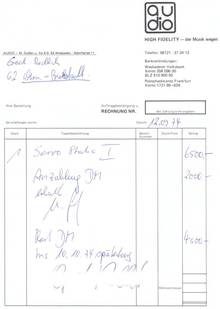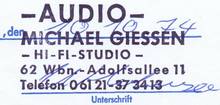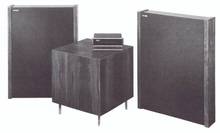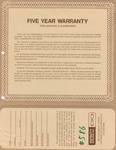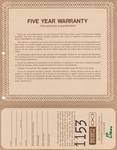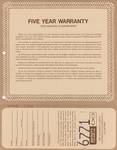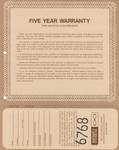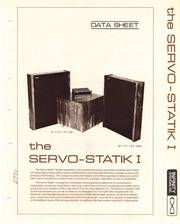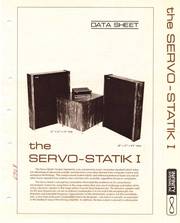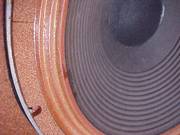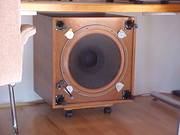Er ist wieder aufgetaucht, mein Hifi-Ordner von 1975
Und da drinnen waren alle Kaufquittungen und Seriennummern und Prospekte von Infinity, Crown, SAE und meinen anderen (Traum-) Geräten von damals.
Nachdem nämlich mein Freund und Partner Norbert sich Ende 1973 eine Infinity SS1 gekauft hatte, ich hatte die in seinem kleinen BMW 2000 ti aus München abgeholt, hatte mein damaliger zwanghafter Spar-Fimmel Erfolg und ich konnte mir auch eine so teure SS1 kaufen.
Angeblich waren diese Edel-Boxen ja extrem rar, doch der Importeur Audio Intl. (Herrmann Hoffmann) konnte die SS1 auf einmal ganz schnell liefern.
Zu dieser Zeit hatte ich gerade angefangen, die ersten Hifi-Geräte für die Firma AUDIO und auch für das Hifi-Studio Pohl in Mainz zu reparieren bzw. zu überprüfen und bei Bedarf neu einzustellen.
Also es hatte gut geklappt und ich war vorerst mal glücklich, denn ich hatte jetzt ja den weltbesten Lautsprecher bei mir zuhause. Der Unterschied zu den anderen Boxen war wirklich grandios, denn die anderen Boxen hatten nicht so viel getaugt.
Da gab es bei mir zwei "Wharfedale Dovedale III" und für meine Disco-Vorführanlage zwei JBL 4310 (ja, die nannten sich wirklich "Studio Monitore" !!), aber das war alles nichts gegen die neue SS1. Und es gab (aber erst viel später) zwei Tannoy Berkeley,
Der Hochtonverstärker war damals ein SAE Mark XXXIB und der Mitteltonverstärker war ein Crown DC 300A. Daß der Baßverstärker der SS1 vernehmlich mit 50Hz brummte, wurde vom anfänglichen euphorischen Genußdenken einfach übertüncht - verdrängt.
Die Garantiescheine waren echte historische "Dokumente"
Die Amis hatten (und haben) es mit der Show. Die vier Garantiescheine hätten die beinahe in massive Holzplatten geritzt, wenn das vertretbar oder annehmbar gewesen wäre. Man hat die daher nur auf ein 220 Gramm Präge-Karton gedruckt und mit großen Lettern die Seriennummern drauf gemalt oder gestempelt.
.
.
Was ich damals auch nicht wußte, daß es ja insgesamt nur etwas weniger als 50 von den SS1 Systemen hier in Europa gegeben hatte. Die Seriennummern täuschen da ganz gewaltig. Nehmen Sie mal nur meine beiden letzten Ziffern der Seriennummern, also Panele Nr. 71 und Nr. 68.
Für Amerika und für die Masse der Amerikaner war das SS1 System mit deutlich über 3000.- Dollar fast so teuer wie eine große Blech-Karosse von Oldsmobile, denn die Verstärker und der Rest der Anlage kamen ja auch noch dazu. Die Amerikaner sind da weitaus preissensibler als wir hier in Deutschland. Ich vermute, daß es weltweit nur etwa 200 Infinity SS1 Systeme gegeben hatte. Von dem Nachfolger - der größeren und verbesserten Infinity SS1a - fanden nur 2 einsame Systeme den Weg nach Europa. Eines davon steht heute noch in Bonames.
.
Rückblick : Über die Zeit davor - also vor dem Kauf :
Damals waren die Zeiten anders als jetzt, es gab noch kein Internet, telefonieren war teuer (vor allem Ferngespräche) und die Kommunikation erfolgte eigentlich einseitig. Das bedeutet, wir lasen und "inhalierten" jegliche Art von Testberichten und solchen nachfolgenden Lobeshymnen. Wer konnte etwas dagegen halten ? Alles schwarz auf weiß Gedruckte wurde zu der Zeit (jedenfalls außerhalb der Politik) noch geglaubt.
Auch waren die Programmquellen nach unseren damaligen Maßstäben bereits hervorragend und wenn es richtig Rummste, war der Bass sehr gut. Und wenn die Geige in Schwanensee auf der teuren DECCA Platte so richtig weinte, waren auch die Höhen in Ordnung.
Kritik war also überhaupt nicht angebracht und ich konnte die SS1 ja bei Norbert in seiner kleinen Wohnung unterm Dach probehören. Und damit war der Kauf der SS1 beschlossene Sache, nur das "Wie", das war noch nicht ganz raus.
Doch jetzt erst mal zu den Lobeshymnen, der folgende Artikel war ja nicht der einzige dieser Art. Es gab ja mehrere Tests und die konnten sich natürlich nicht alle irren.
.
Und das stand auf dem Beipack "DATA-Sheet"
Es war übrigens das gleiche Doppel-Blatt, wie es auch als Prospekt verteilt wurde:
.
"Kompromißloser Musikreproduktions-Standard"
The Servo-Statik I System represents a no-compromise music recreation standard which takes full advantage of advanced acoustic and electronic principles derived from computer science and aerospace technology. This unique sound system totally and without question eclipses any and all other music reproduction systems now commercially available, regardless of size or complexity.
"Sämtliche Probleme konventioneller Lautsprecher eliminiert" (??)
The Servo-Statik I concept has completely eliminated the problems of all conventional electrostatic screens by using them in the range where they truly excel (midrange and treble) while using a dynamic speaker in the range where it excels (bass frequencies).
"Für den Bass kein normaler Lautsprecher"
The dynamic speaker used for the bass frequencies can be no ordinary loudspeaker if it is to match the exceptionally low distortion and extended frequency characteristics of the electrostatic screens. For this formidable task, a new type of dynamic loudspeaker had to be designed -one which is actually incorporated in the feedback loop of the driving amplifier.
.
"Die 16 HZ Orgel kann man fühlen"
In addition, the bass system is placed in a decorative commode of moderate proportions which can be placed almost anywhere in the listening room due to the non-directional characteristics of bass frequencies of 100Hz and below. Thus, for the first time, it is possible to hear/feel the mighty 16Hz organ pedal note and on the same system experience the delicate bowing of strings and the spectacular transients of plucked strings of chamber music.
- Anmerkung : Das war natürlich (von uns damals geglaubter) Schwachsinn, weil physikalisch völliger Unsinn. Nach der glaubwürdigen Aussage von Herrn Brüggemann wurde auf keine Schallplatte dieser Welt eine 16Hz Frequenz drauf geschrieben, kein Tonbandgerät konnte 16Hz speichern und kein UKW Sender konnte 16Hz senden. Alleine die Obertöne hätte man hören können. Weiterhin ist die Wellenlänge von 20 Hz über 18 Meter, also in einem normalen Wohnraum gar nicht zu realisieren. - Und wir hatten das dennoch staunend geglaubt !
.
"Das Servo-Bass Element mit dem Sensor"
The servo bass system employs a small sensing element on the voice coil of the loudspeaker. Since, at frequencies below 100Hz, the cone acts virtually like a perfect piston (Kolben), the output signal from the sensor corresponds exactly to the motion of the loudspeaker itself. The signal recorded in the sensor is proportional to the motion of the loudspeaker; furthermore, all distortions obtained in this moving system are clearly present in the electrical signal obtained from the sensor. This signal, then, is a precise measure of how the output of the loudspeaker system deviates from the driving signal of the power amplifier. It is this signal that is fed back into the input of the amplifier which ultimately drives the speaker into a region of uniform response and low distortion not possible without employing the feedback principle.
"Für den Bass ein 18" Chassis"
For this application a special 18" loudspeaker (16" piston) is utilized, which includes the small sensor in the moving system. This speaker is capable of 3/4" peak-to-peak motion with the sensor remaining linear. In order to appreciate the acoustical power output capabilities of this speaker, one needs only to be aware of the fact that a 16" piston which moves 3/4" peak-to-peak at a frequency of 35Hz is delivering one full acoustic watt of power!
"Genügend Kraft auch für große Wohnzimmer und kleine Säle"
This is enough power at 35Hz to fill an enormous living room if not a small auditorium. The speaker is housed in a four cubic foot box of extremely sturdy construction and is filled with sound absorbing material. The amplifier which drives the bass system is a 110 watt RMS DC amplifier capable of peak powers in excess of 200 watts. It utilizes all-silicon transistors and computer grade components including an integrated circuit operational amplifier at the front end and advanced complementary symmetry circuitry throughout. The amplifier also has contained within it an electronic crossover which correctly feeds the bass system and screens with the proper frequency spectrum.
The peerless sound quality of the electrostatic transducer arises principally because of three factors:
- 1) the extremely low mass of the moving system;
- 2) the driving force is distributed uniformly over the moving diaphragm area, and;
- 3) constant energy output as a function of frequency.
.
"Die Mittelton-Membrane / Folie"
The diaphragm of an electrostatic reproducer is of low mass because it is extremely thin, approximately .0005" in thickness. The low mass gives the screen excellent transient response since the diaphragm can be accelerated very rapidly (due to the small inertial mass) while the resistance of the air load damps out any overshoot.
"Die Hochton-Membrane / Folie"
Moreover, the low mass of the tweeter diaphragm (.00025" in thickness) can give flat frequency response up to and beyond 30KHz. High frequency rolloff occurs when the mass of the diaphragm is equal to the mass reactance of the air load in front of the diaphragm. This occurs at about 30KHz in the Servo-Statik I System, after which the response drops off at 6db per octave.
"Verzerrungen immer unter 0,5%"
The fact that the electrostatic screen utilizes a uniform electric driving force over its entire radiating area serves to virtually eliminate what is called "cone-breakup" (one of the principal factors which produce distortion in conventional loudspeakers, caused by the cone being driven only at its center). In most instances, distortion in screens never exceeds 0.5%.
The Infinity systems' electrostatic speakers differ in design from most conventional units.
.
- First, they are designed for exceptionally high-power handling capacity and therefore can handle most amplifiers fed into them (there are no fuses in series with the speaker line).
- Second, the grids on either side of the diaphragm are highly conductive rather than highly resistive; thereby giving constant power output at all frequencies and exceptional articulation.
.
"Perfekte Abstrahlcharakteristik"
Finally, the dispersion characteristics of the screens are vastly different than most electrostatics. The Servo-Statik I System has eliminated the dispersion problems of conventional units by utilizing narrow strip tweeters and compound angled midrange modules which results in flat frequency response on or off axis. Additionally, the screens radiate 50% of their energy in the rear direction, adding the correct amount of reflected sound in the room and resulting in concert hall realism and smoothness.
Anmerkung :
Da ist Professor Bose aber ganz anderer Meinung. Er sagt, daß über 80% "reflecting sound" nach hinten raus müssen - siehe seine Ausführungen zur Entwicklung der BOSE 901.
.

